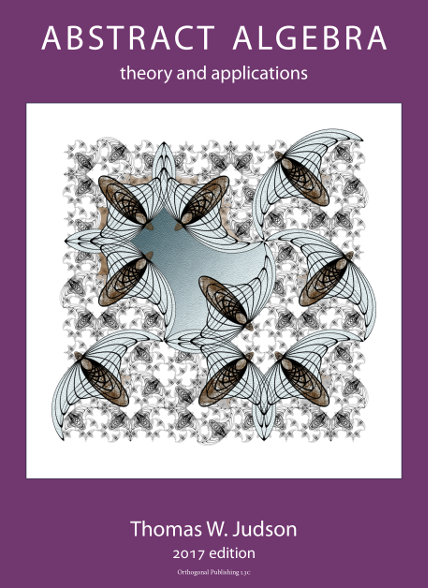Section7.4Lagrange's Theorem
¶
Proposition7.9
Let \(H\) be a subgroup of \(G\) with \(g \in G\) and define a map \(\phi:H \rightarrow gH\) by \(\phi(h) = gh\text{.}\) The map \(\phi\) is bijective; hence, the number of elements in \(H\) is the same as the number of elements in \(gH\text{.}\)
We first show that the map \(\phi\) is one-to-one. Suppose that \(\phi(h_1) = \phi(h_2)\) for elements \(h_1, h_2 \in H\text{.}\) We must show that \(h_1 = h_2\text{,}\) but \(\phi(h_1) = gh_1\) and \(\phi(h_2) = gh_2\text{.}\) So \(gh_1 = gh_2\text{,}\) and by left cancellation \(h_1= h_2\text{.}\) To show that \(\phi\) is onto is easy. By definition every element of \(gH\) is of the form \(gh\) for some \(h \in H\) and \(\phi(h) = gh\text{.}\)
Theorem7.10Lagrange
Let \(G\) be a finite group and let \(H\) be a subgroup of \(G\text{.}\) Then \(|G|/|H| = [G : H]\) is the number of distinct left cosets of \(H\) in \(G\text{.}\) In particular, the number of elements in \(H\) must divide the number of elements in \(G\text{.}\)
The group \(G\) is partitioned into \([G : H]\) distinct left cosets. Each left coset has \(|H|\) elements; therefore, \(|G| = [G : H] |H|\text{.}\)
Corollary7.11
Suppose that \(G\) is a finite group and \(g \in G\text{.}\) Then the order of \(g\) must divide the number of elements in \(G\text{.}\)
Corollary7.12
Let \(|G| = p\) with \(p\) a prime number. Then \(G\) is cyclic and any \(g \in G\) such that \(g \neq e\) is a generator.
Let \(g\) be in \(G\) such that \(g \neq e\text{.}\) Then by Corollary 7.11, the order of \(g\) must divide the order of the group. Since \(|\langle g \rangle| \gt 1\text{,}\) it must be \(p\text{.}\) Hence, \(g\) generates \(G\text{.}\)
Corollary 7.12 suggests that groups of prime order \(p\) must somehow look like \({\mathbb Z}_p\text{.}\)
Corollary7.13
Let \(H\) and \(K\) be subgroups of a finite group \(G\) such that \(G \supset H \supset K\text{.}\) Then
\begin{equation*}
[G:K] = [G:H][H:K].
\end{equation*}
Observe that
\begin{equation*}
[G:K] = \frac{|G|}{|K|} = \frac{|G|}{|H|} \cdot \frac{|H|}{|K|} = [G:H][H:K].
\end{equation*}
Proposition7.15
The group \(A_4\) has no subgroup of order \(6\text{.}\)
Since \([A_4 : H] = 2\text{,}\) there are only two cosets of \(H\) in \(A_4\text{.}\) Inasmuch as one of the cosets is \(H\) itself, right and left cosets must coincide; therefore, \(gH = Hg\) or \(g H g^{-1} = H\) for every \(g \in A_4\text{.}\) Since there are eight \(3\)-cycles in \(A_4\text{,}\) at least one \(3\)-cycle must be in \(H\text{.}\) Without loss of generality, assume that \((123)\) is in \(H\text{.}\) Then \((123)^{-1} = (132)\) must also be in \(H\text{.}\) Since \(g h g^{-1} \in H\) for all \(g \in A_4\) and all \(h \in H\) and
\begin{align*}
(124)(123)(124)^{-1} & = (124)(123)(142) = (243)\\
(243)(123)(243)^{-1} & = (243)(123)(234) = (142)
\end{align*}
we can conclude that \(H\) must have at least seven elements
\begin{equation*}
(1), (123), (132), (243), (243)^{-1} = (234), (142), (142)^{-1} = (124).
\end{equation*}
Therefore, \(A_4\) has no subgroup of order \(6\text{.}\)
In fact, we can say more about when two cycles have the same length.
Theorem7.16
Two cycles \(\tau\) and \(\mu\) in \(S_n\) have the same length if and only if there exists a \(\sigma \in S_n\) such that \(\mu = \sigma \tau \sigma^{-1}\text{.}\)
Suppose that
\begin{align*}
\tau & = (a_1, a_2, \ldots, a_k )\\
\mu & = (b_1, b_2, \ldots, b_k ).
\end{align*}
Define \(\sigma\) to be the permutation
\begin{align*}
\sigma( a_1 ) & = b_1\\
\sigma( a_2 ) & = b_2\\
& \vdots\\
\sigma( a_k ) & = b_k.
\end{align*}
Then \(\mu = \sigma \tau \sigma^{-1}\text{.}\)
Conversely, suppose that \(\tau = (a_1, a_2, \ldots, a_k )\) is a \(k\)-cycle and \(\sigma \in S_n\text{.}\) If \(\sigma( a_i ) = b\) and \(\sigma( a_{(i \bmod k) + 1}) = b'\text{,}\) then \(\mu( b) = b'\text{.}\) Hence,
\begin{equation*}
\mu = ( \sigma(a_1), \sigma(a_2), \ldots, \sigma(a_k) ).
\end{equation*}
Since \(\sigma\) is one-to-one and onto, \(\mu\) is a cycle of the same length as \(\tau\text{.}\)
